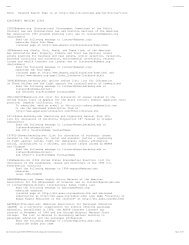BIEDERMANN MOTECH GMBH and Depuy Spine, Inc, Plaintiffs
BIEDERMANN MOTECH GMBH and Depuy Spine, Inc, Plaintiffs
BIEDERMANN MOTECH GMBH and Depuy Spine, Inc, Plaintiffs
You also want an ePaper? Increase the reach of your titles
YUMPU automatically turns print PDFs into web optimized ePapers that Google loves.
Device for stabilizing spinal column segments, comprising a pedicle screw (1) having a threaded shaft<br />
portion (3) <strong>and</strong> a spherically-shaped head (4) at the end of said threaded shaft portion, a receiver member<br />
(5) flexibly connected to said head (4), said receiver member being provided with two holes for receiving a<br />
rod [ (16) ], a receiver chamber (7) being provided within said receiver member (5), the receiver chamber<br />
(7) having at one end thereof a bore (8) for passing the threaded shaft portion (3) therethrough <strong>and</strong> an inner<br />
hollow spherically-shaped portion (9) for receiving the head (4) of said screw (1), an opening (10) being<br />
provided opposite said bore (8) for inserting said screw (1), said device further comprising a compression<br />
member (18) for exerting a force onto said head (4) such that said head is pressed against the hollow<br />
spherically-shaped portion (9).<br />
('678 patent, cl. 1.) Rather, the two limitations of a cylindrical opening in the receiver member <strong>and</strong> the<br />
compression member fitting inside the cylindrical opening are introduced in claims 5 <strong>and</strong> 6 respectively.<br />
Claim 5 reads:<br />
Device according to claim 1, characterized in that said receiver chamber (7) has a hollow cylindricallyshaped<br />
portion (11) opposite to the bore (8) <strong>and</strong> adjacent to the hollow spherically-shaped portion (9).<br />
('678 patent, cl. 5.) Claim 6 reads:<br />
Device according to claim 1, characterized in that said compression member (18) comprises a cylindrical<br />
portion having an outer diameter which is substantially equal to the inner diameter of said hollow cylindrical<br />
portion (11).<br />
('678 patent, cl. 6.) The doctrine of claim differentiation provides that it must be assumed that the dependent<br />
claims were deliberately added so that the independent claim would have a broader scope than the<br />
dependent claims. Curtiss-Wright Flow Control Corp. v. Velan, <strong>Inc</strong>., 438 F.3d 1374, 1380-81<br />
(Fed.Cir.2006); Liebel-Flarsheim Co. v. Medrad, <strong>Inc</strong>., 358 F.3d 898, 909-10 (Fed.Cir.2004). See also Pl. Op.<br />
Br. at 23. Thus, the proper definition for "compression member," it seems, would not include the limitations<br />
that the compression member "must fit inside the cylindrical opening <strong>and</strong> be of sufficient size to exert a<br />
force on the screw head." See <strong>Depuy</strong> <strong>Spine</strong>, 469 F.3d at 1023.<br />
As an example of how the two limitations identified above are not essential to claim 1, <strong>and</strong> as an example<br />
as to why claim 1 should be interpreted more broadly than claims 5 <strong>and</strong> 6, consider an alternative<br />
implementation of the invention. This alternative implementation would use a square-sided compression<br />
member, fitting into a square-sided hollow portion of the receiver member. Such an alternative<br />
implementation arguably would be obvious to try, as the patent specification teaches that both the<br />
compression member <strong>and</strong> the receiver member have four slits spaced 90 degrees apart, where two opposing<br />
slits are sized to receive a threaded rod <strong>and</strong> the other two opposing slits are sized to allow slight deformation<br />
when the nuts are tightened, securing the pedicle screw <strong>and</strong> the threaded rod. ('678 patent, col. 2 l. 42 to col.<br />
31.16.) The four slits spaced 90 degrees apart would correspond neatly to the four sides, angled at 90<br />
degrees, of a square-sided device. Such an alternative implementation would make it easier to align the slits<br />
of the receiver member with the slits of the compression member. There may be countervailing<br />
considerations in considering ease of fabrication or in considering whether such a geometry would allow the<br />
desired deformation upon tightening the nuts. However, the patent specification does not teach that a<br />
cylindrical shape for the compression member <strong>and</strong> hollow portion is particularly suitable <strong>and</strong> does not teach<br />
away from trying other geometries of the compression member <strong>and</strong> hollow portion of the receiver member.






